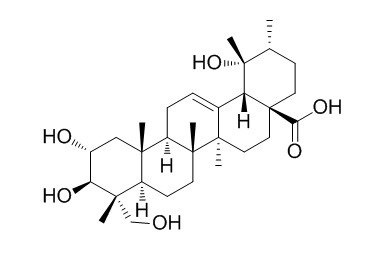19 alpha-Hydroxyasiatic acid
19 alpha-Hydroxyasiatic acid shows significant anticoagulant effect on the extrinsic pathway.
Inquire / Order:
manager@chemfaces.com
Technical Inquiries:
service@chemfaces.com
Tel:
+86-27-84237783
Fax:
+86-27-84254680
Address:
1 Building, No. 83, CheCheng Rd., Wuhan Economic and Technological Development Zone, Wuhan, Hubei 430056, PRC
Providing storage is as stated on the product vial and the vial is kept tightly sealed, the product can be stored for up to
24 months(2-8C).
Wherever possible, you should prepare and use solutions on the same day. However, if you need to make up stock solutions in advance, we recommend that you store the solution as aliquots in tightly sealed vials at -20C. Generally, these will be useable for up to two weeks. Before use, and prior to opening the vial we recommend that you allow your product to equilibrate to room temperature for at least 1 hour.
Need more advice on solubility, usage and handling? Please email to: service@chemfaces.com
The packaging of the product may have turned upside down during transportation, resulting in the natural compounds adhering to the neck or cap of the vial. take the vial out of its packaging and gently shake to let the compounds fall to the bottom of the vial. for liquid products, centrifuge at 200-500 RPM to gather the liquid at the bottom of the vial. try to avoid loss or contamination during handling.
Front Microbiol.2020, 11:583594.
J Biosci.2020, 45:46.
Plant Science2024, 338:111914
Chin. Med.J.Res. Prac.2017, 31(4)
Antimicrob Agents Chemother.2024, e0031424.
Front Immunol.2017, 8:1542
Front Pharmacol.2022, 13:972825.
Biomed Pharmacother.2019, 111:262-269
Molecules.2018, 23(2)
Biofactors.2018, 44(2):168-179
Related and Featured Products
Food Chemistry, 2009, 116(3):633-637.
Ursolic acid analogues: non-phenolic functional food components in Jamaican raspberry fruits[Reference:
WebLink]
The Rubus genus produces numerous species that are known for their medicinal properties. Rubus rosifolius, called the red raspberry, grows wild in elevated regions in Jamaica.
METHODS AND RESULTS:
Phytochemical examination of the ethyl acetate extract of the fruit yielded eight compounds of the 19-α-hydroxyursane type: euscaphic acid (1), 1-β-hydroxyeuscaphic acid (2), hyptatic acid B (3),
19 alpha-Hydroxyasiatic acid(4), trachelosperogenin (5), 4-epi-nigaichigoside F1 (6), nigaichigoside F1 (7), and trachelosperoside B-1 (8), as confirmed by NMR spectroscopy. Inhibition of cell proliferation by these compounds were determined by using MCF-7 (breast), SF-268 (CNS), NCI H460 (lung), HCT-116 (colon) and AGS (gastric) human tumour cells. Among the human tumour cell lines assayed, only compounds 3 and 6 displayed significant growth inhibition and was specific to colon tumour cells by 56% and 40%, respectively. These ursolic acid analogues were also tested for anti-inflammatory activity using in vitro cycloxegenase-1 (COX-1) and cycloxegenase-2 (COX-2) enzyme inhibitory assays.
CONCLUSIONS:
Compounds 1, 2 and 3 showed selective COX-1 enzyme inhibitory activity (13%, 25% and 35%) at 25 μg/ml. In the lipid peroxidation (LPO) inhibitory assays, compounds 2, 4, 7 and 6 inhibited LPO by 62%, 60%, 53% and 68%, respectively, at 25 μg/ml.
Chem Pharm Bull (Tokyo). 2007 May;55(5):784-8.
Production of triterpene acids by cell suspension cultures of Olea europaea.[Pubmed:
17473469 ]
Olive (Olea europaea) contains large quantity of triterpene acids including oleanolic acid (6) as a major one. Varieties of biological activities exhibited by triterpene acids attracted our attentions, especially from pharmaceutical viewpoints. Cell culture of olive plant was induced and its triterpene constituents were studied.
METHODS AND RESULTS:
From the cell suspension cultures, six ursane type triterpene acids; ursolic acid (9), pomolic acid (10), rotundic acid (11), tormentic acid (12), 2alpha-hydroxyursolic acid (13) and 19 alpha-Hydroxyasiatic acid (14), and two oleanane type acids; oleanolic acid and maslinic acid (7), have been isolated. Quantity of ursane type triterpene acids produced by cell cultures was larger than that of oleanane type. Further, a multifunctional oxidosqualene cyclase (OSC) named OEA was cloned by homology based PCRs from the same cultured cells.
CONCLUSIONS:
Major product of OEA is alpha-amyrin (ursane skeleton), showing good accordance to higher content of ursane-type triterpene acids in the cultured cells, and strongly suggesting OEA to be a major contributor OSC for their production.
Phytotherapy Research, 1998, 12(2):146-148.
The anticoagulant effects ofGeum japonicum extract and its constituents.[Reference:
WebLink]
METHODS AND RESULTS:
Anticoagulation activity-guided fractionation led to the isolation of seven triterpenoid compounds from the methanol extract of the whole plant of Geum japonicum and their identification was based on spectroscopic methods.
CONCLUSIONS:
Of these compounds, 19 alpha-Hydroxyasiatic acid (2α, 3β, 19α, 23-tetrahydroxy-12-ursen-28-oic-acid) showed significant anticoagulant effect on the extrinsic pathway.



